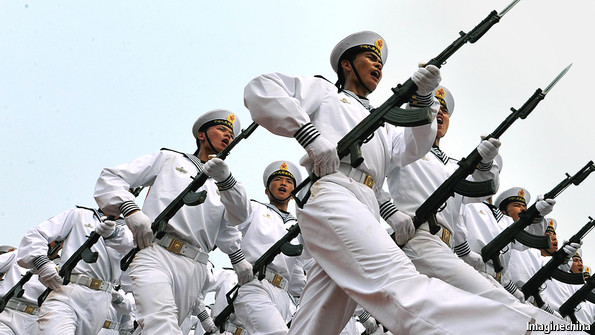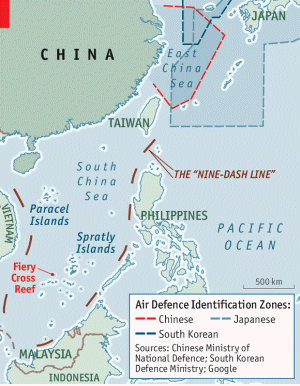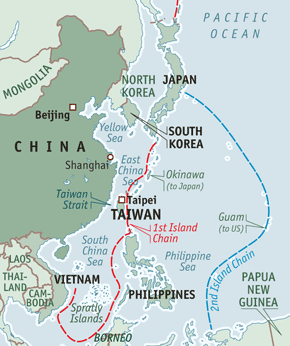War With China: Is It Already Here?
It begins as China claims international waters as its own Sep 12 2015China has hit a rough patch. We've been importing about 8% less than last year, so they've devalued the yuan to make their goods cheaper and our goods more expensive. That way we Americans will boost our imports again, and China will buy less of our products. After all, they need our money to build their air force and navy so they can advance their plan to shut us out of the 
South China Sea and then the western Pacific. We're only too glad to help.
With our military bases dotting the region and our ships plying its waters, the United States has been a dominating presence in the region since our victory in the Pacific 70 years ago rescued China from occupation by the Japanese. But now China wants to become the hegemon. They want us out, and are testing us with provocations. "If there’s a door, China will knock on it, and if there’s no answer, China will try the handle", writes Tod Lindberg of The Weekly Standard.
Meanwhile, as China grows ominously stronger, the U.S. has for the last fourteen years been preoccupied elsewhere, weakening itself in will and wherewithal in the futile morass of a Middle East better left to sort out its own suicidal cravings. President Obama has been steadily distracted from his "pivot" to the Pacific by non-stop critics who want a "strategy" but have none of their own, and in the East is reduced to little more than a trade pact and a smattering of troops sent to Australia. The Chinese must be pleased.
"The ultimate strategic effect of the Iraq war has been to hasten the arrival of the Asian Century. The military trend that is hiding in plain sight is the loss of the Pacific Ocean as an American lake after 60 years of near-total dominance". That's Robert Kaplan, a geo-strategical analyst who seems always to be out ahead of our government. He wrote that in 2007.
The Chinese have been knocking. Ownership of the islands in the South China Sea have always been disputed, the seabed thought to hold oil and natural gas, but China has over the past few years decided to take possession against its weak neighbors. China does not want control of them all, says Wu Shicun, president of a government-sponsored institute, only 80%. A map they issue has nine dash lines 
The nine dash line Credit: The Economist
that reach from the Chinese mainland hundreds of miles almost to the Vietnam, Malaysia, and Philippines coastlines, demarcating a zone they contend is all theirs.
Chinese dredges have been sucking sand from the sea floor to turn reefs into an archipelago of seven islands amidst the Spratly Island group some 500 miles from China and halfway between Vietnam and the Philippines, a sea area so treacherous that old British Admiralty sailing charts marked the entire area “Dangerous Ground”. Over the past year and a half the Chinese reclaimed 2,000 acres from the sea bottom, are building two lighthouses, radar installations, have been spotted unloading artillery, and have laid a 10,000 foot runway capable of handling any aircraft from fighter jets to heavy-lift cargo transports.
This gives them an outpost to "allow Beijing to conduct regular, sustained patrols of the airspace and water, and to attempt to press its far-flung maritime claims as many as 1,000 miles from its shores”, says Mira Rapp-Hooper, director of a website that monitors activity in the disputed territory.
no trespassingIn May, a U.S. Navy P8-A Poseidon surveillance plane overflying Fiery Cross Reef, one of the new islands, was told repeatedly, "This is Chinese navy. You are approaching our military alert zone. Leave immediately in order to avoid misjudgment". A crew from CNN was on board to broadcast their navy's reprimand (delivered in English) and the U.S. crew responding each time that it was flying through international airspace.
The U.S. was told to end its “provocative behavior” by the Chinese foreign ministry. Claim of the reefs is “unshakable”. The American flights are “very irresponsible and dangerous,” and “likely to cause an accident”. The Communist Party's paper, the People’s Daily, warned America that those who “hurt others” could “end up hurting themselves”. The state-owned Global Times of China said unless America stopped objecting to the island-building, war would be “inevitable”.
There have been many other incidents. Our companion article has a rundown .
The South China Sea is is the shortest route between the Pacific and Indian oceans, and the Middle East and Europe beyond. Through its shipping lanes pass half the world's cargo tonnage and 80% of the oil destined for China. That confers outsized strategic importance on this crossroads. Ownership of the several islands, islets, reefs and rock piles of the South China Sea and beyond are perpetually disputed. China and Vietnam both claim sovereignty over the Paracel Islands. China, Vietnam, the Philippines, Brunei and Malaysia all claim sovereignty over the Spratly Islands. Indonesia has been awakened by the realization that China even includes parts of the Natuna. China is claiming them all.
China has a rationale for wanting to protect the tanker routes, a role so far played by the United States navy. Its moves to create artificial islands with military bases are what alarms the countries that ring these waters. And for island nation Japan, almost wholly dependent on trade, China's control poses an enlarged threat. The South China Sea is “on the way to becoming the most contested body of water in the world”, says Kaplan.
What's troubling for the countries that encircle the South China Sea — principally Vietnam, Malaysia, the Philippines — is that Chinese officials and scholars have been referring to the "nine dash line" mentioned above, dashes on a map drawn in 1947 before the Communist victory indicating with territorial claims that almost all the sea belongs to China. This zone is described as a "core national interest". The nine-dash map appears in government documents and even in Air China’s in-flight magazine. Newly-issued Chinese passports now show an image of the line.
A country has exclusive claim to the first 12 miles of surrounding sea under maritime law, and an economic zone of 200 miles for exclusive fishing and mining, but the 200 miles are considered international waters by the U.N. Convention on the Law of the Sea meaning free access for all other purposes. Not for the new China. It has acted to force foreign militaries out of the 200-mile economic zone off them mainland, and now claims the Law of the Sea gives them the 200-mile economic zone extending outward from each islet or rock outcrop that it claims is theirs , blocking all other countries from fishing rights, oil or gas drilling, or sea-floor minerals. They have decreed that any territorial dispute is to be handled only one nation on one, giving Beijing a lopsided advantage over each smaller neighbor. Its economic power makes it the bully in the schoolyard.
down to the sea in ships
The nine dash line? That's for now. China then looks beyond to what a powerful navy will bring. They speak of the "second island chain", seen in this second map 
The 2nd island chain Credit: The Economist
embracing even the American territory of Guam, a key military base, which clearly shows the objective of reducing or eliminating the American presence.
In 2013 a group of Chinese scholars, analysts and military officials gathered to even question Japan's rule of the Ryukyu island chain, which includes Okinawa, home of 1.3 million Japanese and 27,000 American troops.
Finally, in the expectation of becoming the dominant super power, China would look to what they call the "third island chain", extending their maritime reach out into the Pacific where the United States currently has unchallenged naval supremacy. The chain begins with America's and Russia's Aleutian Islands. In unofficial Chinese military literature the southward line includes the Hawaiian Islands.
How will the u.s. respond?In November 2013, China declared an "air defense identification zone" over the Senkaku Islands and the East China Sea. All aircraft entering the zone were required to self-identify. The U.S. acquiesced by advising commercial airlines to comply, which was viewed as a mistake. Japan and South Korea refused. We have since signaled token resistance by flying two B-52s through the zone.
America's policy has for too long been based on the wishful belief that China's often-expressed plan for a "peaceful rise" could be trusted. American corporations have been so lustful of profiting from the potential of the rising Chinese market that they have put up with exclusionary practices, currency manipulation, counterfeiting, trade secret theft and technology transfer — what former NSA chief Gen. Keith Alexander called “the greatest transfer of wealth in history”. Our government had begun to view China as a "strategic competitor", but such talk was toned down by George Bush after the attacks of September 11th 2001, when our focus shifted to the Middle East. Barack Obama is constantly pulled back into that cauldron. Meanwhile, China charges ahead with its island building and threats.
There is concern that China will declare another defense identification zone over the South China Sea, given their nine-dash line claims and rapid build out of its islands. The U.S. last year warned China that it would not accept another identification zone or China's territorial claims of the islands. U.S. Defense Secretary Ashton Carter repeated that warning this May, saying, “There should be no mistake about this: The United States will fly, sail and operate wherever international law allows, as we do all around the world”.
The test of our resolve should come soon, as it must. In a 2012 op-ed, James Webb, former Navy Secretary and now running for president, warned, "History teaches us that when unilateral acts of aggression go unanswered, the bad news never gets better with age."
General Secretary Xi Jinping visits Washington in September when he and President Obama will seek to "ease tensions".
Next time: China's military build-up.
Please subscribe if you haven't, or post a comment below about this article, or
click here to go to our front page.

